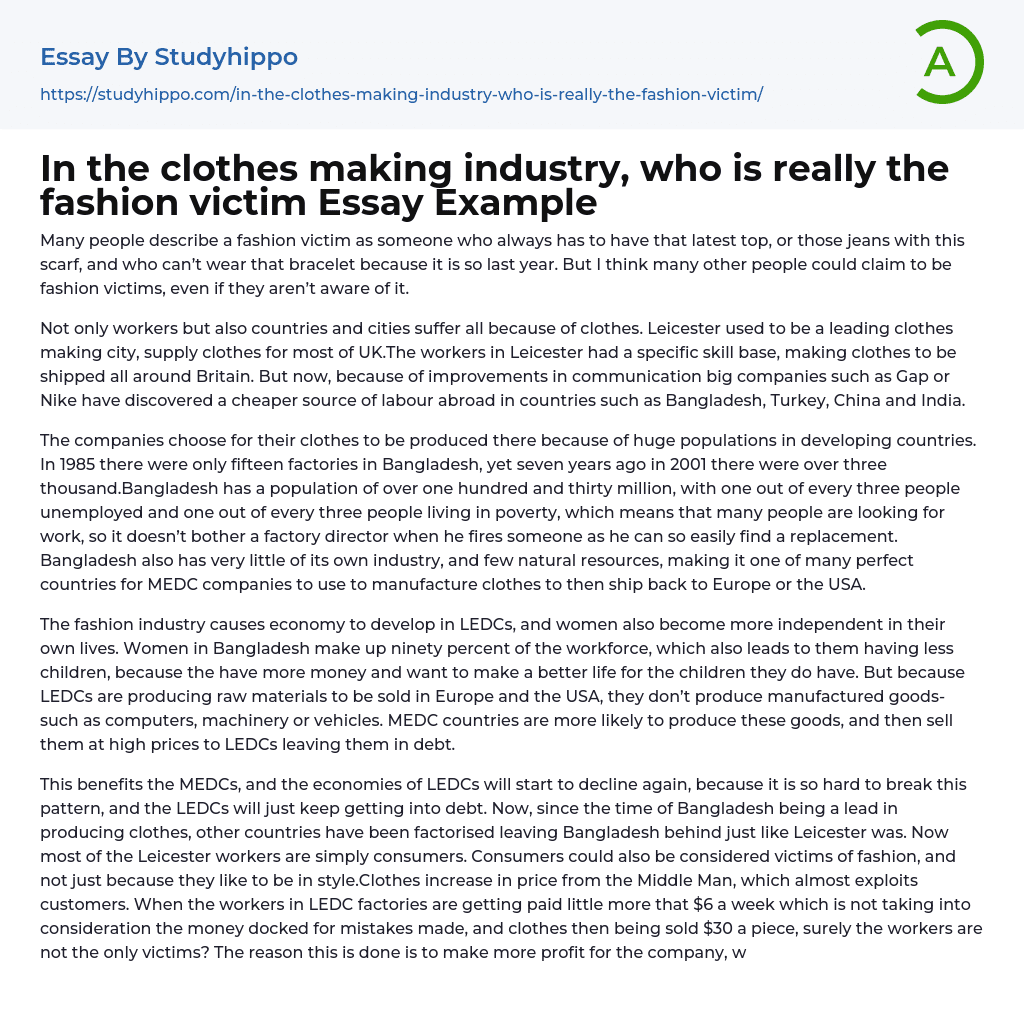

In the clothes making industry, who is really the fashion victim Essay Example
While some people may define a fashion victim as someone who constantly chases the latest trends and avoids items deemed outdated, I believe that many individuals may unknowingly fit this description.
Both cities and workers are negatively affected by the clothing industry. Leicester, a prominent clothing-making city that used to supply clothing for the majority of the UK, now suffers due to advancements in communication that allow large companies like Gap and Nike to find cheaper labor in countries like Bangladesh, Turkey, China, and India. This has resulted in the loss of jobs for skilled clothing workers who used to produce clothes for distribution throughout Britain.
The reason why companies choose to produce their clothes in developing countries is due to the large population size. In 1985, Bangladesh had only fifteen factories but in 2001, there were over three thousa
...nd factories. Bangladesh's population is over one hundred and thirty million with one-third unemployed and living in poverty. This creates a high demand for work and an easy replacement option for factory directors when firing employees. Additionally, Bangladesh lacks its own industry and has few natural resources which makes it an ideal location for MEDC companies to manufacture clothes and ship back to Europe or the USA.
The fashion industry contributes to the economic development of LEDCs, while empowering women to lead more independent lives. In Bangladesh, for example, women comprise 90% of the workforce, which not only boosts their income but also reduces their desire for larger families as they strive to improve living conditions for their children. However, despite producing raw materials for export to Europe and the USA, LEDCs generally lack capacity to manufacture complex
goods like computers, machinery, or vehicles. As such, MEDC countries tend to dominate these markets and charge high prices, leading LEDCs into debt.
MEDCs reap benefits while LEDCs' economies suffer, resulting in a persistent cycle of debt accumulation for the latter. Bangladesh was once a prominent clothing producer but has been surpassed by other countries, much like Leicester. In Leicester, workers have transitioned into becoming consumers who are often exploited by middlemen driving up clothing prices. This exploitation affects not only workers but also customers as LEDC factory workers earn less than $6 per week (with potential deductions) while clothing is sold for $30 each to increase company profits at the expense of its workforce.
Despite claims by companies such as Gap and Nike that they are "child labour free" and free of "sweatshops", evidence has shown that children under fifteen work long hours in some of their factories. This false advertising exploits customer rights and must be addressed by these industry leaders who cannot simply blame fashion trends. It is their responsibility to improve factory conditions and pay, even if it means facing a strike in MEDC countries. As consumers become more conscious of child labor issues, they seek not only affordable clothing but also ethical options. Thus, Gap and Nike must strive to sell more ethical clothing.
Gap, a multi-billion dollar global fashion company, acknowledged in May 2007 the possible use of child labor in the creation of a line of children's clothing in India. Impoverished parents are deceived into selling their children for a few dollars, with the false assurance that they will be well looked after and will return their earnings. Gap's factory
may be the source of these practices, but it is the children who are the true victims, with over 215 million child laborers worldwide, according to the International Labor Organization. The fashion industry is not alone in this issue; other sectors also use child labor. In conclusion, there are more victims of fashion than is commonly understood.
The repercussions of fashion are felt by all mentioned above: either because of the pressure of following it, the adverse conditions in which it is produced, or because they used to be involved in its creation before it went elsewhere. The countries that suffer the most due to this phenomenon are the ones that are left behind. Consumers prioritize affordability, even if that means shifting their manufacturing from Pakistan to Bangladesh, resulting in declining economies and limited job opportunities for women. In Leicester, people may not be poverty-stricken but they aren't swimming in riches either. The fashion industry is cutthroat and neglects the impact on those who become leftover when production moves elsewhere. While consumers are becoming more aware of ethical concerns, it will take a considerable amount of time before they think about the consequences for those who manufacture our clothes when production changes countries.
- Jeans essays
- Automotive essays
- Real Estate essays
- Construction essays
- E Commerce essays
- Commerce essays
- Polymers essays
- Automotive Industry essays
- Paper Industry essays
- Textile Industry essays
- Pharmaceutical industry essays
- Pharmacy essays
- Grocery stores essays
- Classical Mechanics essays
- Rail Transport essays
- Tata Motors essays
- Vehicle Brands essays
- trucks essays
- Auto Racing essays
- Harley-Davidson essays
- Suzuki essays
- Lexus essays
- Mercedes-Benz essays
- Buying Homes essays
- Futures Contract essays
- Mortgage Loan essays
- Renting essays
- Transaction Cost essays
- Building essays
- Optical Fiber essays
- Freezing essays
- Polymer essays
- Weaving essays
- Affirmative Action essays
- Assisted Suicide essays
- Capital Punishment essays
- Censorship essays
- Child Labour essays
- Child Protection essays
- Civil Rights essays
- Corporal Punishment essays
- Death Penalty essays
- Empowerment essays
- Euthanasia essays
- Gay Marriage essays
- Gun Control essays
- Human Trafficking essays
- Police Brutality essays
- Privacy essays
- Sex Trafficking essays



